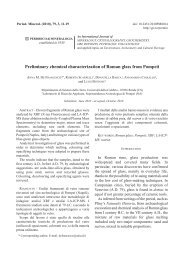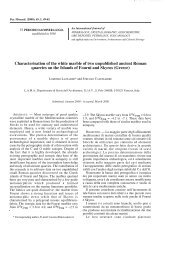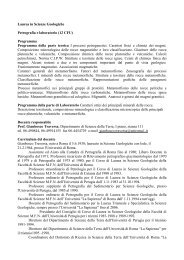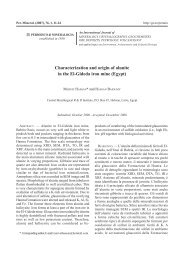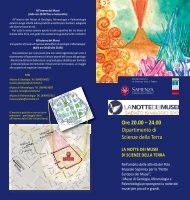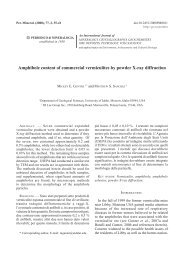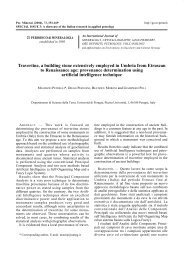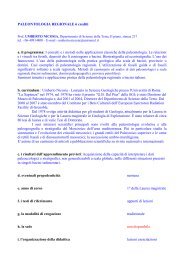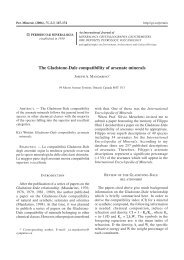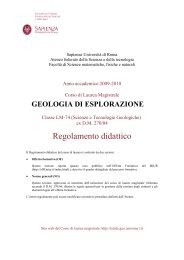Full text - Dipartimento di Scienze della Terra - Sapienza
Full text - Dipartimento di Scienze della Terra - Sapienza
Full text - Dipartimento di Scienze della Terra - Sapienza
- No tags were found...
You also want an ePaper? Increase the reach of your titles
YUMPU automatically turns print PDFs into web optimized ePapers that Google loves.
Per. Mineral. (1999), 68, 3, 261-273<br />
n PERIODICO <strong>di</strong> MINERALOGIA<br />
established in 1930<br />
An International Journal of<br />
MINERALOGY, CRYSTALLOGRAPHY, GEOCHEMISTRY,<br />
ORE DEPOSITS, PETROLOGY, VOLCANOLOGY<br />
and applied topics on Environment, Archaeomet1y and Cultural Heritage<br />
Analcimization processes in the pyroclastic rocks from Phlegraean Fields<br />
(southern Italy): compositional variations and geochemical balances<br />
MARIA ROSARIA GHIARA1*, CARMELA PETTI1 and PAOLA MORBIDELLI2<br />
'<strong>Dipartimento</strong> <strong>di</strong> <strong>Scienze</strong> <strong>della</strong> <strong>Terra</strong>, Universita Federico II, Via Mezzocannone 8, I-80134 Napoli, Italy<br />
2 <strong>Dipartimento</strong> <strong>di</strong> <strong>Scienze</strong> <strong>della</strong> <strong>Terra</strong>, Universita La <strong>Sapienza</strong>, P.le Aldo Moro 5, I-00185 Roma, Italy<br />
Submitted, July 1999- Accepted, November 1999<br />
ABSTRACT. -A series of scoriaceous fragments<br />
collected from pyroclastic fall dep osits belonging to<br />
<strong>di</strong>fferent volcanoes of the Phlegraean Field s<br />
(Neap les, Italy) shows progressive stages of<br />
analcimization. Particularly, major and trace<br />
elements and 87Srf86Sr ratio in non-altered and<br />
altered samp les from the Fond o Riccio volcano have<br />
been determined. With increasing analcimization the<br />
following geochemical balance ap p ears: Si and K<br />
decrease, AI, Na and Fe increase, Ca and Mg remain<br />
constant. Pb is dep leted whereas Rb is slightly<br />
enriched in the more analcimized samp les. All rareearth<br />
elements do not show any significant<br />
<strong>di</strong>fference between non-altered and altered samp les.<br />
87Srf86Sr ratio strongly decreases in the more altered<br />
samp les. Chemical variations observed in the<br />
sc oriaceous fragments from the Fond o Riccio<br />
volcano, suggest that the analcimization proc ess<br />
occurs in an op en system and that a fluid comp onent<br />
enriched in N a is involved . Therefore in a<br />
petrogenetic mod elling, Pb, Rb, and 87Srf86Sr must<br />
be used with very caution.<br />
RIASSUNTO. - Coni <strong>di</strong> sc orie monogemc1<br />
ap p artenenti all' attivita stromboliana recente dei<br />
Camp i Flegrei sono stati camp ionati estesamente. Le<br />
sc orie sono risultate affette da <strong>di</strong>versi grad i <strong>di</strong><br />
analcimizzazione. I bilanci geochimici, effettuati<br />
* Con·espon<strong>di</strong>ng author, E-Mail: mghiara@unina.it<br />
comp arand o scorie analcimizzate e non, hanno d ato i<br />
seguenti risultati: a) i contenuti in silice e potassio<br />
<strong>di</strong>minuiscono con I' aumentare del grad o <strong>di</strong><br />
analcimizzazione m entre per il sod io e I' alluminio si<br />
registrano chiari incrementi; b) gli elementi in tracce<br />
e le terre rare non subiscono, ad eccezione del<br />
rubid io e del piombo, significative variazioni; c) nei<br />
camp ioni a piu elevato contenuto in analcime si<br />
registra una perd ita <strong>di</strong> stronzio rad iogenico. Le<br />
variazioni geochimiche sono state attribuite a<br />
processi <strong>di</strong> interazione tra i prod otti scoriacei ed i<br />
fluid i id rotermali legati all' attivita fumarolica.<br />
KEY WoRDS : Analcimization process, geochemical<br />
balance, latitic rocks, Phlegraean Fields.<br />
INTRODUCTION<br />
Zeolitization processes are commonly<br />
observed in the potassic volcanic rocks of the<br />
Roman region although there are only few<br />
stu<strong>di</strong>es devoted to defining the geochemical<br />
balance (major and trace elements) during<br />
these alterations (Fornaseri and Penta, 1960;<br />
Cundari and Graziani, 1964; Barbieri et al.,<br />
1977; Calderoni et al., 1985; Giannetti and<br />
Masi, 1989; Giampaolo et al., 1997).
262 M.R. GHIARA, C. PETTI and P. MORBIDELLI<br />
The most information, moreover, is restricted<br />
to N a and K elements and to leucite into<br />
analcime transformation, whereas a large<br />
quantity of data concerning the mechanisms<br />
and the control of the zeolitization process and<br />
the fluid/solid interaction in closed and in<br />
simulated open systems on <strong>di</strong>fferent rock-types<br />
is available (Holler and Wirsching, 1978;<br />
Hawkins, 1981; Wirsching, 1981; Barth<br />
Wirsching and Holler, 1989; Franco et al.,<br />
1989-90; Ghiara et al., 1993, 1994; Ghiara and<br />
Petti, 1996).<br />
The lack of data on geochemical variations<br />
connected to alterations is, of course, a crucial<br />
problem in petrogenetic modelling which is<br />
only based on the behaviour of major and trace<br />
elements. Moreover, it is to be noted that the<br />
glass alteration is not always easily<br />
recognizable in thin section and so apparently<br />
fresh samples may have experienced minor<br />
alteration. Therefore, accurate X-ray stu<strong>di</strong>es are<br />
required to find out about the presence or<br />
absence of secondary minerals.<br />
A suitable way to define geochemical<br />
balances is to study coeval and<br />
petrographically comparable rocks with<br />
<strong>di</strong>fferent degrees of analcimization.<br />
A good opportunity is given by scoria cones<br />
belonging to fourth cycle of Phlegraean<br />
volcanism (Di Girolamo et al., 1984). With this<br />
objective in mind, we have undertaken a<br />
detailed petrological and geochemical study of<br />
several monogenetic scoria cones which have<br />
been extensively sampled.<br />
In this paper we report geochemical<br />
variations observed in petrographically<br />
comparable glassy and scoriaceous fragments<br />
which have experienced <strong>di</strong>fferent<br />
analcimization degrees and coming from the<br />
recent scoria cone of Fondo Riccio.<br />
The present study will hopefully shed a light<br />
on:<br />
1) post-depositional alteration of the glassy<br />
matrix lea<strong>di</strong>ng to analcime crystallization;<br />
2) geochemical changes of major and trace<br />
elements occurring in the analcimization<br />
process.<br />
GEOLOGICAL SETTING<br />
The Phlegraean Fields, located in the<br />
Neapolitan Region (southern Italy), are a<br />
Quaternary and historically active volcanic<br />
area. The last eruption occurred (Monte<br />
Nuovo) in 1538 and now the area shows<br />
fumarolic and hydrothermal activity. The<br />
oldest products (Torre Franco Tuff) are about<br />
42,000 years old (Alessio et al., 1976;<br />
Cassignol and Gillot, 1982).<br />
From a volcanological point of view, the<br />
Phlegraean Fields are mainly made up of<br />
volcanoclastic deposits, often related to<br />
phreatomagmatic eruption, minor lava flows<br />
and domes (Di Girolamo et al., 1984).<br />
Quaternary volcanic products of the<br />
Phlegraean Fields belong to the shoshonitic<br />
series of the Roman province where more or<br />
less evolved rocks (e.g. trachytes and minor<br />
phonolites) predominate over mafic or<br />
interme<strong>di</strong>ate ones (shoshonitic basalts and<br />
latites) (Di Girolamo et al., 1984).<br />
Aphyric to subaphyric Phlegraean rocks are<br />
chiefly composed of a glassy matrix with<br />
scattered few phenocrysts (Ghiara et al., 1979;<br />
Armienti et al., 1983; Di Girolamo et al.,<br />
1984 ). Post-depositional alteration, inclu<strong>di</strong>ng<br />
zeolites (e.g. analcime) as alteration products<br />
of glassy matrix, adularia and albite,<br />
overgrowths on primary sani<strong>di</strong>ne laths, have<br />
been frequently observed. Other secondary<br />
minerals are: fluorite and, to a lesser extent,<br />
calcite, epidote and hematite (Armienti et al.,<br />
1983; Beccaluva et al., 1991).<br />
MATERIALS AND METHODS<br />
Scoriaceous fragments from pyroclastic fall<br />
deposits belonging to Minopoli, Fondo Riccio,<br />
Concola, S. Teresa, Senga, and Monte Nuovo<br />
volcanoes (Ghiara et al., 1977; Ghiara, 1989-<br />
90) were sampled along vertical sections. From<br />
a volcanological point of view, these volcanic<br />
centres are monogenetic scoria cones produced<br />
by a strombolian-like volcanic activity.<br />
Pyroclastic deposits consist of rather poorly
Analcimization processes in the pyroclastic rocks from Phlegraen Fields (Southern Italy)... 263<br />
welded and coarse-grained scoria with<br />
decimeter-sized ballistic bombs and blocks.<br />
Scoriaceous fragments are arranged in <strong>di</strong>screte<br />
and overlain layers formed during the build up<br />
of the cone. Only few beds are connected to<br />
mass-flow processes resulting from<br />
avalanching and rolling of scoria deposits.<br />
From the Fondo Riccio cone eleven <strong>di</strong>screte<br />
layers were sampled from bottom to top (Fl<br />
Fl1 samples). Nearly all the layers range from<br />
40 to 80 cm in thickness with the exception of<br />
the seventh layer (F7) which is 4 m thick. Only<br />
one layer (F4) is mainly formed by a finegrained<br />
vitric tuff and it shows glassy<br />
fragments with apparent <strong>di</strong>fferences in the<br />
vesciculation degree.<br />
Bulk rock composition (major and trace<br />
elements) was determined by X-ray<br />
fluoroscence spectrometry (Philips PW 1400<br />
XRF spectrometer), using pressed powder<br />
pellets, accor<strong>di</strong>ng to the method of Franzini et<br />
al. (197 5) and Leoni and Sai tta (197 6).<br />
International standards were used for<br />
calibration; the precision for major elements<br />
are usually estimated to be below 3%. Mg and<br />
N a were determined by atomic absorption<br />
spectrophotometry (Perkin-Elmer model 21 00)<br />
and analytical precision is within ± 1%. The<br />
analytical precision is better than 5% for Sr, Zr<br />
and Ba and better than 10 % for other trace<br />
elements. REE were determined by ICP-MS at<br />
CRPG, Nancy, France (Govindarju and<br />
Mevelle, 1987).<br />
The analcime contents were measured,<br />
accor<strong>di</strong>ng to Parker (1978), using a Philips PW<br />
1730 X-ray <strong>di</strong>ffractometer (40 kV, 30 mA)<br />
with Ni-filtered Cuka ra<strong>di</strong>ation. In order to<br />
better define the analcime type, thermal<br />
analysis (DT A, TG and DTG) was performed<br />
using a Netzsch Geratebau GMBH instrument<br />
with a heating rate of 1 0°C/min between 20-<br />
10000C.<br />
Scanning electron microscope analyses were<br />
made using a Cambridge Stereoscan model 250<br />
MK3 equipped with EDS Link model AN<br />
10/55 S. Microprobe analyses were carried out<br />
on automated ARL SEMQ (C.N.R. Cagliari)<br />
(accelerating voltage 15 k V; beam current 20<br />
nA). Natural silicates and oxides were used as<br />
standard materials. On-line correction for drift,<br />
dead-time and background was applied to the<br />
raw data. All data were corrected using ZAF<br />
FLS program.<br />
Strontium separation was carried out by<br />
<strong>di</strong>ssolution of samples in HF and HC104 acids<br />
and by passage through a 50 x 8 (200-400<br />
mesh) cation exchange resin. 87SrJ86Sr ratios<br />
were measured on a VG Isomass 54E mass<br />
spectrometer (CNR, Roma). For the NBS 987<br />
SrC03 standard, the mean value of 0. 71024 ±<br />
0.00002 was achieved, with a standard<br />
deviation of 0.00001 (15 measurements).<br />
RESULTS<br />
Classification and petrographic notes<br />
20<br />
Ne<br />
fs<br />
Peralkaline<br />
• phonolitic<br />
10 ...<br />
trachytes<br />
···---- ---· -- ·--<br />
In the present paper a classification based on<br />
CIPW normative composition is used. In the<br />
Differentiation Index (D.I.) vs Nepheline (Ne)<br />
classification grid (Armienti et al., 1983) the<br />
investigated rocks fall into the following five<br />
main fields: 1) shoshonites, 2) latites, 3)<br />
trachytes, 4) alkali trachytes and 5) peralkaline<br />
phonolitic trachytes (fig. 1).<br />
All the scoriaceous fragments are<br />
subrounded, dark -coloured and homogeneous<br />
in hand samples. They are aphyric to sub-<br />
Shoshonites Latites • Trachytes Alkalitrachytes<br />
•til<br />
•<br />
# f<br />
1'-<br />
,;J' 4 A<br />
D.l.<br />
:.<br />
.1.<br />
0<br />
40 50 60 70 80 90 100<br />
Fig. 1 - Plot of D.J. vs Ne (%) for Minopoli ( + ), Fondo<br />
Riccio (•), Concola (0), Mt. Santa Teresa (..t.), Senga (X),<br />
and Mt. Nuovo (0) scoriaceous fragments. D.l.=<br />
Ab+Or+Ne+Lc. Classification <strong>di</strong>agram mo<strong>di</strong>fied from<br />
Armienti et al. (1983).
264 M.R. GHIARA, C. PETTI and P. MORBIDELLI<br />
aphyric contammg
Analcimization processes in the pyroclastic rocks from Phlegraen Fields (Southern Italy)... 265<br />
TABLE 2<br />
Microprobe analyses of analcime (1 and 2), Ti-magnetite (3), and glass (4)frmn sample Fl.<br />
I<br />
2 3 4<br />
Si02<br />
Ti02<br />
Al203<br />
Fe203 (tot)<br />
M gO<br />
CaO<br />
Na20<br />
K20<br />
M nO<br />
Cr203<br />
0<br />
Si<br />
Ti<br />
AI<br />
Fe<br />
Mg<br />
Ca<br />
Na<br />
K<br />
Mn<br />
Cr<br />
[5]<br />
56.20<br />
21.61<br />
0.70<br />
0.15<br />
0.67<br />
9.78<br />
1.68<br />
( cr) [5]<br />
(1.15) 55.80<br />
(0.45) 21.83<br />
(0.03) 0.69<br />
(0.05) 0.11<br />
(0.02) 0.79<br />
(0.35) 9.85<br />
(0.15) 1.82<br />
96<br />
33.12<br />
15.01<br />
0.31<br />
0.13<br />
0.42<br />
11.18<br />
1.26<br />
(cr) [7] ( cr) [6] ( cr)<br />
( 1.28) 1.85 (0.58) 56.66 (1.32)<br />
12.63 (1.30) 0.80 (0.01)<br />
(0.15) 2.82 (0.50) 17.85 (0.65)<br />
(0.01) 78.68 ( 1.40) 6.49 (0.30)<br />
(0.05) 2.36 (0.08) 1.88 (0.07)<br />
(0.03) 0.86 (0.04) 4.96 (0.03)<br />
(0.25) 2.95 (0.53)<br />
(0.15) 7.85 (0.20)<br />
0.60 (0.02) 0.15 (0.01)<br />
0.20 (0.06)<br />
96 32 80<br />
32.93 0.49 26.74<br />
2.50 0.28<br />
15.18 0.87 9.93<br />
0.31 15.57 2.31<br />
0.10 0.92 1.32<br />
0.50 0.24 2.50<br />
11.27 2.70<br />
1.37 4.73<br />
0.13 0.06<br />
0.09<br />
Ulv %<br />
[ ]: number of analysis for each sample; (cr): Estimated standard deviations are given to the right of each number. Fe 2 03 ( tot ) : total iron. 0:<br />
number of oxygens; E%: total balance error from Gottar<strong>di</strong> and Galli (1985). Ulv %: ulvospinel mol. %, calculated utilizing Fe 3 +, Fe 2 +<br />
accor<strong>di</strong>ng to Droop (1987).<br />
36.1<br />
2) only few samples of alkalitrachytes show<br />
analcime peaks which are absent in the samples<br />
of peralkaline phonolitic trachytes;<br />
3) the analcime amount of fragments coming<br />
from a single volcano varies as follows:<br />
Minopoli 10 - 27%, Fondo Riccio 0 - 27 %,<br />
Concola 9 - 20 %, Santa Teresa 0-18% and<br />
Senga 0 -14 % by volume (Table 1);<br />
4) the analcime amount of fragments coming<br />
from a single layer is strongly variable [e.g. M3<br />
-M3' (16 -2%), C1 -Cl' (12 -20 %) and F4 -<br />
F4' (0 -11 %)] (Table 1).<br />
Thermal analyses<br />
Fig. 2 SEM images of analcimized sample (Fl) from<br />
Fondo Riccio volcano: (Ani) : analcime, (T): Ti-magnetite,<br />
(G): unaltered glass.<br />
Simultaneous DTA-TG-DTG analyses were<br />
carried out on analcime-rich samples (e.g. Fl<br />
and M3'). The samples show a dehydration<br />
band between 235 and 320°C; accor<strong>di</strong>ng to<br />
Giampaolo and Lombar<strong>di</strong> ( 1994) this
266 M.R. GHIARA, C. PETTI and P. MoRBIDELLI<br />
30<br />
ani<br />
• •<br />
20 •<br />
. ..-<br />
•<br />
•<br />
•<br />
10<br />
. ..<br />
•<br />
• Na/K<br />
0<br />
0 2 4<br />
Fig. 3 - Analcime (ani) contents vs Na/K ratios of all<br />
samples from Table I.<br />
analcime contents evaluated on the basis of X<br />
ray <strong>di</strong>ffraction and they can be roughly used to<br />
estimate the degree of analcimization (fig. 3).<br />
The variation <strong>di</strong>agrams reveal that some<br />
elements (e.g. K20 and Na20) are more or less<br />
62 ----<br />
behaviour is typical of X-type analcime which<br />
is mainly formed by leucite alteration whereas<br />
hydrothermal analcime, <strong>di</strong>splays a strong sharp<br />
endothermic peak between 350 and 370°C.<br />
Microprobe analyses and scanning electron<br />
microscope<br />
The electron microscope coupled with<br />
microprobe analyses on the glassy matrix of F1<br />
sample in<strong>di</strong>cate the following main <strong>text</strong>ures<br />
produced by devetrification processes:<br />
1) spherulitic-like <strong>text</strong>ures consisting of<br />
ra<strong>di</strong>ating aggregates of warm-shaped Fe-Ti<br />
opaques (Table 2; fig. 2);<br />
2) patchy <strong>text</strong>ures following a sharp<br />
boundary between very fine-grained<br />
analcimized and unaltered regions (Table 2;<br />
fig. 2)<br />
The analcime compositions are comparable<br />
to that of literature. The ulvospinel content of<br />
newly formed opaques is 36. 1 wt %.<br />
Microprobe analyses on unaltered parts of glass<br />
are strictly comparable to whole-rock analyses<br />
obtained for fresh sample (e.g. F11, Table 3a).<br />
Major and trace elements variations<br />
50<br />
8<br />
8<br />
4-<br />
0<br />
Na20<br />
•<br />
•<br />
•<br />
f.::· •<br />
. ,.<br />
X .6. ..<br />
•<br />
Scoriaceous fragments of each volcanic<br />
centre <strong>di</strong>splay narrow variations in their MgO<br />
content (e.g. M gO from 2. 11 to 2. 78 wt % in<br />
the Fondo Riccio volcano); this matches the<br />
monogenetic character of scoria cones.<br />
However, wide variations of the Na/K ratios<br />
and consequently of normative nepheline<br />
amounts at same D.I. value occur (Table 1; fig.<br />
3). The Na/K ratios are positively correlated to<br />
4<br />
•<br />
• •<br />
•<br />
M gO<br />
0 +---------------<br />
0 2 4 6<br />
Fig. 4- Si01, Na10 and K10 (wt%) variations of<br />
scoriaceous fr a gme n ts plotted - against MgO (wt%). For<br />
symbols see fig. 1
Analcimization processes in the pyroclastic rocks from Phlegraen Fields (Southern Italy)... 267<br />
scattered. This scattering is more evident in<br />
samples coming from Fondo Riccio, Minopoli<br />
and Concola volcanoes which, on the basis of<br />
X-ray patterns, show wide variations in the<br />
analcime content (see Table 1). Particularly, in<br />
the products of Fondo Riccio volcano, the<br />
Na20 and K20 define a «within-trend» which<br />
does not overlap with the general trend (fig. 4).<br />
Major and trace element compositions of<br />
latitic scoriaceous fragments from the Fondo<br />
Riccio volcano are given in Tables 3a and 3b.<br />
The samples show wide variations in Na20 and<br />
K20 contents (from 3. 11 to 6.26 wt % and<br />
from 3. 26 to 7.40 wt % respectively) which,<br />
moreover, are negatively correlated; in ad<strong>di</strong>tion<br />
to the K20 decrease is coupled with a slight<br />
Al203 increase. The other major elements are<br />
nearly constant. The Fondo Riccio samples<br />
<strong>di</strong>splay trends (in the plots K20 vs Al203 and<br />
Na20) moving towards the analcime field (fig.<br />
Sa). The loss of K20 is roughly balanced by<br />
increases of Na20 and Al203.<br />
As for trace elements, only Pb is depleted<br />
whereas Rh is slightly enriched in the strongly<br />
analcimized samples (e.g. F1) (fig. 5b). Rb<br />
increase has been previously observed by<br />
Fornaseri and Penta ( 1960) and by Giannetti<br />
and Masi (1989) in the analcime from leucite<br />
alteration. Other trace elements do not show<br />
significant variations in the Fondo Riccio rock<br />
suites (Table 3b ).<br />
The patterns of chondrite-normalized REE<br />
are shown in figure 6a. Like for most trace<br />
elements, no significant <strong>di</strong>fference between<br />
non-altered and altered rocks samples is found.<br />
In ad<strong>di</strong>tion, no REE fractionation occurs during<br />
analcimization processes as clearly suggested<br />
by KIN a vs La/Yb <strong>di</strong>agram (fig. 6b ).<br />
Sr isotope ratios of several rock samples<br />
from the Fondo Riccio volcano are given in<br />
TABLE 3a<br />
Bulk-rock chemical analyses and C.I.P. W. norms of latitic scories from Fondo Riccio volcano. The<br />
samples are arranged in stratigraphic order frmn bottom to top.<br />
F 1 F2 F3 F4 F4' F5 F6 F7 F8 F9 F10 F 11<br />
Si02 54.63 54.45 54.35 54.57 55.49 54.87 55.34 55.61 54.57 54.56 55.27 55.78<br />
Ti02 0.94 0.98 0.98 0.99 0.92 1.01 0.92 0.91 0.95 0.98 0.91 0.90<br />
Al203 18.27 18.11 18.19 17.66 17.39 17.41 18.05 17.94 18.33 17.55 17.82 17.37<br />
Fe203 7.89 8.12 8.10 8.29<br />
7.49<br />
8.15 7.66 7.25 8.12 8.16 7.43 7.07<br />
M nO 0.14 0.14 0.14 0.14 0.16 0.14 0.14 0.14 0.15 0.15 0.14 0.15<br />
M gO 2.20 2.34 2.26 2.25 2.40 2.57 2.11 2.18 2.78 2.55 2.54 2.11<br />
CaO 5.78 5.96 6.05 5.98 5.85 5.83 5.55 5.31 5.94 5.92 5.80 5.80<br />
Na20 6.26 5.83 5.20 3.87 3.00 3.76 5.42 4.95 4.45 3.71 2.52 3.11<br />
K20 3.26 3.61 4.20 5.68 6.90 5.83 4.34 5.29 4.31 5.97 6.99 7.40<br />
PzOs 0.51 0.46 0.53 0.53 0.40 0.43 0.47 0.42 0.40 0.44 0.58 0.31<br />
Or 19.0 21.1 24.4 33.6 41.4 34.6 25.4 31.0 25.4 35.4 41.7 44.0<br />
Ab 39.7 37.5 35.0 26.4 21.0 28.2 37.3 32.8 35.7 26.1 17.6 23.8<br />
An 11.6 12.4 13.9 14.8 13 .8 13 .5 12.1 11.0 17.3 13.7 16.9 11.7<br />
Ne 9.9 8.6 7.0 5.8 3.8 3.4 6.6 6.8 2.5 4.3 3.2 2.5<br />
Di 11.0 11.0 10.1 9.2 10.4 10.1 9.8 9.9 7.6 10.2 8.2 9.0<br />
01 3.8<br />
4.3 4.5<br />
5.1 5<br />
5.3<br />
4.0 3.7 6.7 5.2 6.9<br />
Mt 2.5 2.6 2.6 2.6 2.5 2.6 2.5 2.5 2.6 2.6 2.7 2.5<br />
Il 1.3 1.4 1.4 1.4 1.2 1.4<br />
1.3<br />
4.4<br />
1.3 1.3 1.4 1.5 1.3<br />
Ap 1.1 1.0 1.1 1.1 0.9 0.9 1.0 0.9 0.8 0.9 1.2 0.8<br />
Major elements (wt%) normalized to H20-free basis; H20 content ranges from 0.75 to 1.34 wt%. F4 ' from<br />
the same layer of F4 .
268 M.R. GHIARA, C. PETTI and P. MORBIDELLI<br />
TABLE 3b<br />
Trace element contents (ppm) in latitic scories from the Fondo Riccio volcano.<br />
F1 F2 F3 F4 F4' F5 F6 F7 F8 F9 F 10 F 11<br />
Li 17 21 18 21 21<br />
23 24 16 19 18<br />
Rb 370 355 305 258 270 270 278 260 327 293 305 300<br />
P b 14 21 23 33 35 36 31 37 31 36 43<br />
Sr 880 890 900 920 853 855 845 835 876 880 905 835<br />
Ba 1760 1765 1690 1695 2037 1700 1727 1730 2275 1710 1850 1740<br />
y 28 28 28 30 29 27 31 29<br />
Zr 215 210 220 215 292 215 215 220 272 225 245 240<br />
V 210 220 215 217 160 206 198 131 177 202 195 171<br />
Nb 32 30 30 33 40 32 32 34<br />
Cr 23 22 28 19 11<br />
16 31<br />
23 24<br />
Co 17 18 18 17 17 18 15 14<br />
16 17<br />
Ni 10 8 10 10 15 8 7 10 16 10 11 11<br />
Zn 89 94 92 94 90<br />
90 92<br />
96 96 95<br />
19<br />
27<br />
93<br />
29<br />
42<br />
14<br />
41<br />
53<br />
25<br />
43<br />
39 28 29<br />
34 36 36<br />
La 56.7 57.8 56.0 56.9 59.2 54.0 61.3 61.9 58.5 63.0 56.1 59.9<br />
Ce 114.1 114.6 113.5 110.6 116.2 110.6 118.3 116.2 114.1 119.0 109.1 119.5<br />
Nd 50.1 50.8 49.1 51.8 51.2<br />
52.7 52.3 52.3 n.d. 51.1 50.0<br />
Sm 10.3 10.2 10.3 10.6 10.2 10.1 10.9 10.5 10.3 n.d. 10.1 10.1<br />
Eu 2.40 2.40 2.40 2.40 2.40 2.30 2.50 2.40 2.40 n. d. 2.50 2.40<br />
Gd 7.40 7.40 7.40 7.90 7.50 7.30 8.30 8.00 7.80 n. d. 7.60 7.10<br />
Dy<br />
5.65 5.34 5.54 5.37 5.46 5.73 5.65 5.64 n.d. 5.51 5.38<br />
Er 2.59 2.58 2.55 2.66 2.60 2.53 2.72 2.68 2.59 n. d. 2.61 2.56<br />
Yb<br />
2.40 2.36 2.62 2.54 2.42 2.67 2.55 2.56 n.d. 2.43 2.50<br />
Lu 0.39 0.37 0.39 0.37 0.40 0.37 0.38 0.37 0.40 n.d. 0.38 0.41<br />
5.45<br />
2.43<br />
n. d.: not detected<br />
47.4<br />
24<br />
14<br />
25<br />
Alz03<br />
15<br />
Na20<br />
20<br />
10 bA<br />
15<br />
••<br />
••<br />
5<br />
·- '• • ·-<br />
.. .<br />
KzO<br />
I 0<br />
0 2 4 6 8 0 2 4 6 8<br />
Fig. Sa- Vari ation <strong>di</strong>agrams [A1203 and Na20 (wt%) vs K20 (wt%)] of the scori a ceou s fragments from Fondo Riccio (e),<br />
an alcime this work (L'l)<br />
K,O<br />
500 50<br />
400<br />
Rb<br />
300 Fl •<br />
200<br />
100<br />
K20<br />
2 3 4 5 6 7 8<br />
Pb<br />
• •<br />
40-<br />
• • •<br />
30- •<br />
•<br />
20- • •<br />
10-<br />
0<br />
Fl<br />
K20<br />
2 3 4 5 6 7 8<br />
Fig. 5b - Variation <strong>di</strong>agrams [Rb and P b (pp m) vs K20 ( wt%)] of the scoriaceou s fragment s from Fondo Riccio.
Analcimization processes in the pyroclastic rocks from Phlegraen Fields (Southern Italy) ... 269<br />
TABLE 4<br />
Sr isotope compositions of representative<br />
scoriaceous fragments of F ondo Riccio volcano<br />
FIO<br />
F 11<br />
F4'<br />
F4<br />
F8<br />
F3<br />
F1<br />
87 SrJ 86 Sr<br />
0.70785±0.00002<br />
0. 70790±0.00003<br />
0. 70786±0.00002<br />
0. 70786±0.00003<br />
0.70776±0.00002<br />
0.70743±0.00002<br />
0.70745±0.00002<br />
F4 ' from the same layer of F4 .<br />
Table 4. 87SrJ86Sr ratios remain quite constant<br />
in the non-altered or relatively altered samples<br />
but with increasing analcimization (i.e. samples<br />
with 23-27 % in analcime) 87SrJ86Sr abruptly<br />
decrease (fig. 7).<br />
DISCUSSION<br />
X-ray data and re-equilibration <strong>text</strong>ures<br />
observed in SEM investigations clearly reveal<br />
that the glassy matrix of scoriaceous fragments<br />
coming from Phlegraean Fields volcanic<br />
products has experienced an alteration process<br />
lea<strong>di</strong>ng to very fine-grained analcime<br />
aggregates.<br />
On the whole, the analcimization process<br />
progressively decreases towards the evolved<br />
rocks (i.e. alkalitrachytes and peralkaline<br />
phonolitic trachytes). This is conform to the<br />
lower reactivity of felsic glass compared with<br />
basic glass reactivity as clearly shown by<br />
Ghiara and Petti (1996) in fluid/rock<br />
interaction experiments.<br />
The study of geochemical mo<strong>di</strong>fications<br />
produced by analcimization processes on<br />
glassy fragments is the main goal of the present<br />
paper and consequently we have chosen the<br />
Fondo Riccio samples because they show<br />
a) wider data scattering in variation <strong>di</strong>agrams;<br />
b) low <strong>di</strong>fferences in the M gO content;<br />
c) wider variations in the analcime content.<br />
In order to explain the Fondo Riccio trends<br />
the most relevant <strong>text</strong>ural, mineralogical and<br />
chemical features of the scoriaceous fragments<br />
are:<br />
a) all the investigated juvenile fragments are<br />
aphyric to sub-aphyric and so the scattered<br />
chemical trends cannot be related to<br />
accumulation processes of phenocrysts;<br />
b) X-ray and microprobe analyses in<strong>di</strong>cate<br />
that the re-equilibration product of metastable<br />
glass is mainly represented by analcime;<br />
c) X-ray quantitative analyses clearly<br />
in<strong>di</strong>cate that the glassy matrix of scoriaceous<br />
fragments have experienced <strong>di</strong>fferent degrees<br />
of subsolidus re-equilibration;<br />
d) K20 and Na20 are negatively correlated<br />
and tend, as expected, towards the analcime<br />
field (fig. Sa).<br />
In order to compare unaltered and altered<br />
rocks, the major elements are usually<br />
normalized to the least mobile element during<br />
alteration processes. Titanium is often used for<br />
normalization owing to its low solubility and<br />
mobility during alteration processes (Nesbitt,<br />
100<br />
10<br />
40<br />
30<br />
20<br />
10<br />
0<br />
I I I<br />
LaCe Nd SmEu Gd Dy Er Yb Lu<br />
La/Yb<br />
b<br />
·- •<br />
Na/K<br />
2 3<br />
Fig. 6-Chondrite-normalized REE patterns (a) and La/Yb<br />
vs Na/K atomic ratio (b) of representative scoriaceous<br />
fragments of Fondo Riccio volcano. Normalizing values<br />
from Boynton (1984).
270 M.R. GHIARA, C. PEITI and P. MoRBIDELLI<br />
TABLE Sa<br />
Half-anhydrous Earth's standard cell contents (on the basis of 80 o.>..,ygens) of bulk rock; the<br />
samples are ordered accor<strong>di</strong>ng to t1e increasing of the analcimization process.<br />
F 11 F9 F5 F4<br />
F7<br />
F8 F6 F3 F2 F1<br />
Si 26.33 25.81 25.86 25.74 25.98 25.70 25.92 25.54 25.56 25.58<br />
Ti 0.32 0.32 0.32 0.32 0.32 0.32 0.32 0.32 0.32 0.32<br />
Al 9.66 9.76 9.78 9.84 9.93 10.12 9.96 10.07 10.02 10.13<br />
Fe 3 :t- 2.51 2.90 2.89 2.94 2.63 2.86 2.70 2.86 2.87 2.78<br />
Mg 1.55 1.72 1.67 1.58 1.53 1.73 1.47 1.58 1.64<br />
Ca 2.87 2.98 2.93 3.01 2.71 2.97 2.77 3.03 2.98 2.89<br />
Na 2.85 3.40 3.44 3.54 4.50 4.04 4.92 4.74 5.31 5.70<br />
K 4.46 3.60 3.51 3.42 3.17 2.58<br />
2.59<br />
1.54<br />
2.52 2.16 1.96<br />
Mn 0.06 0.06 0.06 0.06 0.06 0.06 0.06 0.06 0.06 0.06<br />
p 0.12 0.18 0.17 0.21 0.17 0.16 0.19 0.21 0.18 0.20<br />
Na/K 0.64 0.94 0.98 1.03<br />
1.43<br />
1.56 1.89 1.89 2.44 2.94<br />
TABLE Sb<br />
Atomic <strong>di</strong>fferences observed in the main elements involved during the analcimization process, with<br />
respect to an unaltered sample ( F 11 ).<br />
Si-Si Al-Al Mg-Mg<br />
Ca-Ca Na-Na K-K Na/K<br />
F 11<br />
F9 -0.52 0.10 0.17<br />
F5 -0.41 0.12 0.12<br />
F4 -0.60 0.18 0.03<br />
F7 -0.35 0.27 -0.02<br />
F8 -0.63 0.46 -0.18<br />
F6 -0.42 0.30 -0.08<br />
F3 -0.80 0.41 0.03<br />
F2 -0.78 0.36 0.09<br />
F 1 -0.75 0.47 -0.01<br />
0.64<br />
0.11 0.55 -0.86 0.94<br />
0.06 0.59 -0.95 0.98<br />
0.14 0.69 -1.04 1.03<br />
-0.16 1.65 -1.29 1.43<br />
0.10 1.20 -1.88 1.56<br />
-0.10 2.07 -1.86 1.89<br />
0.16 1.89 -1.94 1.89<br />
0.11 2.46 -2.30 2.44<br />
0.02 2.86 -2.50 2.94<br />
Na/K atomic ratio<br />
1979; Middelburg et al., 1988). In the Fondo<br />
Riccio rock-suite Ti-value of F11 sample have<br />
been used to normalize all the altered samples.<br />
Moreover, assuming that alteration process<br />
takes place without appreciable change in<br />
volume and in order to have a better<br />
comparison between Fondo Riccio rocks, all<br />
the major elements have been normalized using<br />
half of Earth's anhydrous standard cell (Barth,<br />
19S2) (Table Sa). This procedure allows the<br />
comparison of values unaffected by molecular<br />
weight and the reproduction of a more realistic<br />
feature of chemical variations occurring in the<br />
analcimization processes.<br />
The results of a quantitative comparison<br />
between unaltered sample (F11) and altered<br />
samples are given for each major element in<br />
Table Sb and plotted in figure 8.<br />
From the overall data set the following<br />
geochemical balance appears:<br />
1) Si and K decrease whereas AI and Na<br />
increase clearly suggesting an open system<br />
during devitrification and ensuing alteration;<br />
2) Ca and Mg, however scattered, can be
Analcimization processes in the pyroclastic rocks from Phlegraen Fields (Southern Italy)... 271<br />
0.7081 ,...-----,<br />
87Srf6Sr<br />
0.7079 JFll e<br />
F4<br />
FlO p4•<br />
0.7077<br />
0.7075<br />
F3<br />
Fl 11<br />
0.7073 +-----,...-----,-----!<br />
0 2 Na/K 3<br />
Fig. 7 87Srf86Sr vs Na/K atomic <strong>di</strong>agram for<br />
representative samples from the Fondo Riccio volcano.<br />
Phlegraean Fields. Indeed, the fluids sprea<strong>di</strong>ng<br />
out from Phlegraean fumaroles, solfataras and<br />
thermal springs <strong>di</strong>splay a high salinity mainly<br />
of the so<strong>di</strong>um-chloride type (Cortecci et al.,<br />
1977; Ghiara et al., 1988). Moreover, an<br />
alteration model involving trapped<br />
hydrothermal fluids is in good agreement with<br />
spatial <strong>di</strong>stribution of analcimization degrees<br />
which are more elevated in the lower portion of<br />
scoria cones.<br />
The important role played by interacting<br />
fluids is confirmed also by 87Srf86Sr ratios<br />
considered quite constant;<br />
3) the lack of Fe 2 +/Fe 3 + ratios preclude to<br />
understand the iron behaviour;<br />
4) in the less altered rocks (e.g. F9 and F5)<br />
the K loss is mainly balanced by Na increase;<br />
5) in the more analcimized rocks (e.g. Fl and<br />
F2) the Na increase is higher than K decrease;<br />
6) N a/K and Si/ AI atomic ratios<br />
progressively increase (from 0.64 to 2.94) and<br />
decrease (from 2.73 to 2. 52), respectively and<br />
they can be used as index of the degree of<br />
analcimization.<br />
As to 4 and 5 points this behaviour is like<br />
due to <strong>di</strong>fferent glass/interaction fluids ratios. It<br />
has to be remarked that, respect to unaltered<br />
rocks, K concentrations are depleted up to 56%<br />
and N a contents are enriched up to 100% in the<br />
strongly analcimized rocks.<br />
Chemical variations observed m the<br />
Phlegraean glassy rocks defer from those<br />
detected by Giampaolo et al., (1997) in leucitebearing<br />
lava flow; in the latter in ad<strong>di</strong>tion to K,<br />
a Ca and Mg loss is also observed.<br />
Most trace elements, inclu<strong>di</strong>ng REE<br />
concentrations, are essentially conservative,<br />
even at significant degrees of analcimization of<br />
glassy products of Phlegraean Fields<br />
volcanism. Conversely, only Pb is clearly<br />
removed (Pb ( FI/Pb ( FI I) 0.33), and Rb is<br />
=<br />
slightly enriched (Rb (<br />
Fl)/Rb ( FII )<br />
= 1.23).<br />
This geochemical scenario is compatible<br />
with fluid-glass interaction processes in an<br />
open system and requires fluids enriched in<br />
so<strong>di</strong>um. These fluids are likely connected to<br />
hydrothermal and fumarolic activity of<br />
1.5 -,-----,<br />
0.5<br />
-0.5<br />
esi oAI<br />
• •<br />
•<br />
•<br />
0<br />
0<br />
• •<br />
-1.5 ...._ ______________ __,<br />
1.5 -r-----,<br />
0.5<br />
-0.5<br />
-1.5<br />
eMg<br />
OCa<br />
_.__ _____________ ___,<br />
3 .0 -r----.<br />
•<br />
eNa OK<br />
• I<br />
1.0<br />
•<br />
-<br />
-1.0<br />
---()-, -----<br />
Fll Q<br />
0<br />
0 0<br />
0 0<br />
-3.0 ..J..----1<br />
0 1 2 Na/K 3<br />
Fig. 8 Chemical <strong>di</strong>fferen ces observed in the main<br />
elements involved during the analcimization process, with<br />
respect to the unaltered sample (Fl l) plotted against Na/K<br />
atomic ratio.
272 M.R. GHIARA, C. PETTI and P. MoRBIDELLI<br />
which in the more analcimized samples<br />
decrease (fig. 7). Accor<strong>di</strong>ng to Blum et al.,<br />
(1994) and Matter et al., (1991) during a<br />
fluid/rock interaction the fluid component is<br />
enriched in ra<strong>di</strong>ogenic strontium.<br />
CONCLUSIONS<br />
The latitic scoriaceous fragments collected<br />
from a single volcano show that the glassy<br />
matrix has experienced progressive stages of<br />
analcimization. Geochemical balances carried<br />
out on major elements suggest that the<br />
analcimization process takes place in an open<br />
system mainly involving a clear K and a low Si<br />
loss and N a and AI gain.<br />
All the observed geochemical changes are<br />
mainly constrained by the chemistry of newly<br />
formed minerals (e.g. analcime); the K loss is<br />
likely due to the lack of favourable chemical<br />
con<strong>di</strong>tions (e.g. Si/Al) in the system which do<br />
not allow a capture in order to form other<br />
secondary minerals.<br />
On the basis of comparison with other<br />
analcimized rocks belonging to Roman<br />
province no general scheme can be proposed<br />
for the chemical and isotopic changes<br />
occurring in the widespread analcimization<br />
processes.<br />
Most trace element concentrations, with the<br />
exception of Rb and Pb, are not mo<strong>di</strong>fied by<br />
analcimization processes and therefore they can<br />
be used in petrogenetic modelling of<br />
Phlegraean Fields suites. On the contrary,<br />
isotopic ratios must be used with caution.<br />
ACKNOWLEDGMENTS<br />
The authors are ind ebted to Prof. M. Barbieri for<br />
help in isotop ic analyses and constructive<br />
<strong>di</strong>scussion. Sp ecial thanks are exp ressed to Prof. C.<br />
Garbarino for assistance in the microp robe analyses.<br />
We would to thank Prof. E. Passaglia for<br />
constructive comments.<br />
This research was performed with grants from the<br />
MURST60 %.<br />
REFERENCES<br />
ALESSIO M., BELLA F., lMPROTA S., BELLUOMINI G.,<br />
CALDERONI G., CORTESI C. and TURI B. (1976)<br />
University of Rome Carbon-14 Dates XIV.<br />
Rad iocarbon, 18, 321-349 .<br />
ARMIENTI P., BARBERI F., LIZOUARD H., CLOCCHIATTI<br />
R., lNNOCENTI F., METRICH N., Rosi M. and<br />
SBRANA A. (1983 ) - The Phlegraean Fields:<br />
magma evolution within a shallow chamber. J.<br />
Vole. Geotherm. Res., 17, 289-311.<br />
BARBIERI M., DOLFI D. and TRIGLIA R. (19 77)<br />
Sulla gene si dell' analcime delle vulcaniti <strong>di</strong><br />
Crowsnest alla luce del comportamento geochimico<br />
del rubi<strong>di</strong>o nelle blainnoriti e durante il processo <strong>di</strong><br />
analcimizzazione <strong>della</strong> leucite fino a PH 0 3 kb.<br />
Rend . Soc. It. Mineral. Petrol., 33, 55-62 . 2<br />
BARTH T.F.W. (195 2)- Theoretical Petrology, a<br />
Textbook on the origin and evolution of Rocks.<br />
Wiley, New York, 398 pp.<br />
BARTH- WIRSCHING U. and HOLLER H. (1989) -<br />
Experimental stu<strong>di</strong>es on zeolite formation<br />
con<strong>di</strong>tions. Eur. J. Miner., 1, 489-506 .<br />
BECCALUVA L., DI GIROLAMO P. and SERRI G. (1991)<br />
- Petrogenesis and tectonic setting of Roman<br />
Volcanic Province, Italy. Lithos, 26, 191-221 .<br />
BLUM J.D., EREL Y. and BROWN K. (1994 ) -<br />
87Srf86Sr ratios of Sierra Nevada stream waters:<br />
Implications for relative mineral weathering rates.<br />
Geochim. Cosmochim. Ac ta, 58,5019-5025 .<br />
BOYNTON W.B. (1984)- Cosmochemistry of the<br />
rare earth elements: Meteoritic stu<strong>di</strong>es. In «Rare<br />
Earth Element Geochemistry» Hend erson P. (ed .),<br />
Elsevier, Amsterd am, 63-10 7.<br />
CALDERONI G., FERRI T., GIANNETTI B. and MASI U.<br />
(1985 ) - The behavior of thallium during<br />
alteration of the K-alkaline rocks from the<br />
Roccamonfina volcano (Campania, southern<br />
Italy). Chem.Geol., 48, 103-113 .<br />
CASSIGNOL C. and GILLOT P.Y. (1982)- Range and<br />
effectiveness of unspiked potassium-argon dating:<br />
experimental groundwork and application. In:<br />
«N umerical dating in stratigrap hy», Od in G.S.,<br />
Willey J. and Sons (ed s), New York, 160-1 79.<br />
CORTECCI G., NOTO P. and PANICHI C. (19 77)<br />
Environmental isotopic study of the Campi Flegrei<br />
(Naples, Italy) geothermal field. J. Hyd rol., 36,<br />
143-159.<br />
CUNDARI A. and GRAZIANI G. (1964)- Prodotti <strong>di</strong><br />
alterazione <strong>della</strong> leucite nelle vulcaniti vicane.<br />
Per. Mineral., 33, 35-43 .<br />
DI GIROLAMO P., GHIARA M.R., LIRER L., MUNNO<br />
R., ROLANDI G. and STANZIONE D. (1984) -<br />
Vulcanologia e petrologia dei Campi Flegrei.<br />
Boil. Soc. Geol. It., 103, 349-413<br />
DROOP G.T.R. (198 7) -A general equation for
Analcimization processes in the pyroclastic rocks from Phlegraen Fields (Southern Italy) ... 273<br />
estimating Fe3+ concentrations in ferromagnesian<br />
silicates and oxides from microprobe analyses,<br />
using stoichiometric criteria. Mineral. Mag. , 51,<br />
431-435.<br />
FORNASERI M. and PENTA A. (1960) - Elementi<br />
alcalini minori negli analcimi e il foro<br />
comportamento ne! processo <strong>di</strong> analcimizzazione<br />
<strong>della</strong> leucite. Per. Mineral. , 29, 85-102 .<br />
FRANCO E. , PETTI C. , STAZIONE D. , GHIARA M. R.<br />
and MARCHETIELLO A. ( 1989-90) - Stu<strong>di</strong> sugli<br />
equilibri chimici e sui minerali <strong>di</strong> neoformazione<br />
nell'interazione H20-leucite. Boil. Soc. Natur. ,<br />
Nap oli, 98-99, 25-39.<br />
FRANZINI M. , LEONI L. and SAITTA M. (1975) -<br />
Revisione <strong>di</strong> una metodologia analitica per<br />
fluorescenza-X, basata sulla correzione completa<br />
degli effetti da matrice. Rend. Soc. It. Miner.<br />
Petrol. , 31, 365-378.<br />
GHIARA M. R. (1989-1990) - Stu<strong>di</strong>o evolutivo del<br />
sistema magmatico flegreo negli ultimi 10 KA.<br />
Boil. Soc. Natur. , Nap oli, 98-99,41-70 .<br />
GHIARA M. R. , LIRER L. and MUNNO R. (1979) -<br />
Mineralogy and geochemistry of the «Low<br />
Potassium series» of the Campania volcanics<br />
(South Italy). Chem. Geol. , 26, 29-49.<br />
GHIARA M. R. , RoLANDI G. and STAZIONE D. (1977)<br />
- Evoluzione delle vu lcaniti a! affinita<br />
shoshonitica dei Campi Flegrei s. l. : Su<strong>di</strong>o<br />
petrologico e geochintico. Per. Mineral., 46 ,<br />
99-124 .<br />
GHIARA M. R. , FRANCO E. , PETTI C. , STANZIONE D.<br />
and VALENTINO G.M. (1993 ) -Hydrothermal<br />
interaction between basaltic glass, deionized<br />
water and seawater. Chem. Geol., 104, 125-138.<br />
GHIARA M. R. , PETTI C. , FRANCO E. and STANZIONE D.<br />
(1994)- Hydrothermal alteration process of<br />
volcanic glasses in a closed system at 200°C: Zeolite<br />
fonnation. Materials Engineering, 52, 131-144.<br />
GHIARA M. R. and PETTI C. (1996) - Chemical<br />
alteration of volcanic glasses and related control<br />
by secondary minerals: experimental stu<strong>di</strong>es.<br />
Aquatic Geochemistry, 1, 329-354 .<br />
GHIARA M. R. , STANZIONE D. , BELLUCCI L. and<br />
PANICHI C. (1988)- Preliminary observations on<br />
the chemical variations of the solutes monitored in<br />
the thermal waters of the Phlegraean Fields in the<br />
period 1983-1985. Rend. Soc. It. Mineral. e<br />
Petrol. , Sp ecial Vol. 43, 1139-1150.<br />
GIAMPAOLO C. , GODANO R.F. , DI SABATINO B. and<br />
BARRESE E. (1997) - The alteration of leucitebearing<br />
rocks: a possible mechanism. Eur. J.<br />
Mineral. , 9, 1277-1291.<br />
GIAMPAOLO C. and LOMBARDI G. (1994)- Thermal<br />
behaviour of analcimes from two <strong>di</strong>fferent genetic<br />
environments. Eur. J. Mineral. , 6, 285-289.<br />
GIANNETTI B. and MASI U. (1989)- Trace element<br />
behavior during weathering of leucite in potassic<br />
rocks from the Roccamonfina volcano ( Campania,<br />
Southern Italy) and environmental implications.<br />
Lithos, 22, 317-324 .<br />
GOTTARDI G. and GALLIE E. (1985 ) - Natural<br />
zeolites. Sp ringer-Verlag, Berlin, 409 pp.<br />
GOVINDARJU K. and MEVELLE G. (1987) - <strong>Full</strong>y<br />
automated <strong>di</strong>ssolution and separation methods for<br />
inductively coupled plasma atomic emission<br />
spectrometry rock analyses. Application to the<br />
determination of REE. J. An. Atom. Sp ec tr. , 2,<br />
615-621 .<br />
HAWKINS D. B. (1981) - Kinetics of glass<br />
<strong>di</strong>ssolution and zeolite formation under<br />
hydrothermal con<strong>di</strong>tions. Clay and Clay Minerals,<br />
29, 331-340 .<br />
HOLLER H. and WIRSCHING U. (1978) -<br />
Experiments on the formation of zeolites by<br />
hydrothermal alteration of volcanic glasses. In:<br />
Sand L. B. and Mump ton F.A.( ed s) , Pergamon<br />
Press, Elmsford , New York, 329-336<br />
LEONI L. and SAITTA M. (1976) - X- Ray<br />
fluorescenze analysis of 29 trace elements in rock<br />
and mineral stand ard s. Rend. Soc. it. Mineral.<br />
Petrol. , 32 , 497-510 .<br />
MIDDELBURG J. J. , VAN DER WEIJDEN C.H. and<br />
WOITTIEZ J. R. W. (1988) - Chemical processes<br />
affecting the mobility of major, minor and trace<br />
elements during weathering of granitic rocks.<br />
Chem. Geol. , 68, 253-273 .<br />
NESBITT H. W. (1979)- Mobility and fractionation<br />
af rare earth elements during weathering of a<br />
grano<strong>di</strong>orite. Nature, 279, 206-210.<br />
PARKER R. J. (1978)- Quantitative determination of<br />
analcime in pumice samples by X-ray <strong>di</strong>ffraction.<br />
Mineral. Mag. , 42 , 103-106 .<br />
MATTER A. , PETERS TJ. and RAMSEYER K. (1991)<br />
Strontium isotopes in groundwaters and minerals.<br />
In: Ap p lied Isotop e Hyd rogeology A Case Stud y<br />
In Northern Switzerland , Pearson Jr. F. J. ,<br />
Bald erer W., Loosi H. H. , Lehmann B. E. , Matter<br />
A. , Peters Tj., Sc hmassmann H. and Gautschi A.<br />
(ed s.) , Elsevier, 323-335.<br />
WIRSCHING U. (1981) - Experiments on the<br />
hydrothermal formation of calcium zeolites. Clays<br />
and Clay Minerals, 29, 171-183 .



